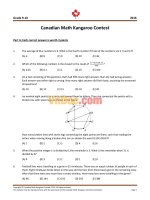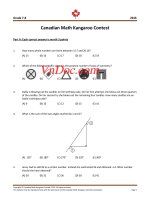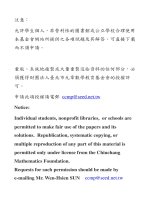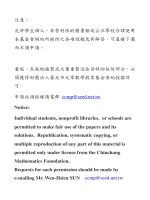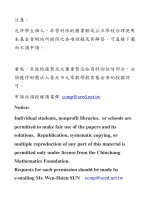Đề thi Toán quốc tế PMWC năm 2008
Bạn đang xem bản rút gọn của tài liệu. Xem và tải ngay bản đầy đủ của tài liệu tại đây (174.16 KB, 4 trang )
<span class='text_page_counter'>(1)</span><div class='page_container' data-page=1>
注意:
允許學生個人、非營利性的圖書館或公立學校合理使用
本基金會網站所提供之各項試題及其解答。可直接下載
而不須申請。
重版、系統地複製或大量重製這些資料的任何部分,必
須獲得財團法人臺北市九章數學教育基金會的授權許
可。
申請此項授權請電郵
<b>Notice: </b>
<b>Individual students, nonprofit libraries,</b>
<b>or schools are </b>
<b>permitted to make fair use of the papers and its </b>
<b>solutions.</b>
<b>Republication, systematic copying, or </b>
<b>multiple reproduction of any part of this material is </b>
<b>permitted only under license from the Chiuchang </b>
<b>Mathematics Foundation. </b>
</div>
<span class='text_page_counter'>(2)</span><div class='page_container' data-page=2>
Po Leung Kuk
12
th
Primary Mathematics World Contest
Team Contest 2008
Team :
<b> </b>
<b>(All the figures are not drawn to scale.) </b>
1. In the figure below, <i>AE</i> = 30 cm, <i>CE</i> = 60 cm, <i>BE </i>= 80 cm and <i>DE </i>= 40 cm.
What is the ratio of the total area of Triangle III and Triangle IV to the total area
of Triangle I and Triangle II?
2. The digits of a 3-digit number, which are all different, are rearranged to form
new numbers. The greatest such number and the smallest such number are still
3-digit numbers. The difference between the greatest number formed and the
smallest number formed is the original 3-digit number. What is the original
number?
</div>
<span class='text_page_counter'>(3)</span><div class='page_container' data-page=3>
4. Simon wants to travel from city <i><b>X</b></i> to city <i><b>Y</b></i>. He is to travel according to the arrow
directions of the following map.
In how many ways can Simon reach city <i><b>Y</b></i>?
5. A digit is placed in each of the 11 boxes below such that the sum of any three
consecutive boxes is equal to 21. If digit “7” is in the first box and digit “6” is in
the ninth box (counting from left to right), what is the digit in the second box?
6. In the figure below, <i>ABCD</i> is a square, <i>AM</i> = <i>NB</i> = <i>DE</i> = <i>CF</i> = 1cm and
<i>MN</i> = 2cm. Find the area of quadrilateral <i>PQRS,</i> in cm2.
<b>7 ? 6 </b>
<i><b>L </b></i> <i><b>P</b></i>
<i><b>Y </b></i>
<i><b>M</b></i>
<i><b>X </b></i> <i><b>Q</b></i>
<i><b>S</b></i>
<i><b>N </b></i>
<i><b>O </b></i>
</div>
<span class='text_page_counter'>(4)</span><div class='page_container' data-page=4>
7. In the figure below, <i>IFD</i> and <i>JED</i> are two arcs in the circles with the same radius.
<i>AD </i>= <i>DB </i>= <i>DC </i>= 4 cm. <i>AGDHB</i>, <i>AFC</i> and <i>BEC</i> are straight line segments. <i>IA</i>, <i>FG</i>,
<i>CD</i>, <i>EH</i> and <i>JB</i> are perpendicular to <i>AB</i>. Find the area of the shaded region,
in cm2. (<b>Take π as</b>
7
22
)
8. The figure below originally was a big cube consisting of 125 small cubes. Some
of the small cubes were taken away. They are shown as dark parts which go
through the entire big cube. How many small cubes are left?
9. Susan goes to the post-office to buy five stamps of the same denomination and
she wants her stamps all connected in one piece. The post master takes out the
last set of nine stamps available as shown below. In how many ways can the
stamps be torn-off?
(Stamps must be connected along an entire edge, not just at a vertex.)
</div>
<!--links-->



